-
- marketing agility
- Teams
- Organizations
- Education
- enterprise
- Articles
- Individuals
- Transformation
- Solution
- Leadership
- Getting Started
- business agility
- agile management
- going agile
- Frameworks
- agile mindset
- Agile Marketing Tools
- agile marketing journey
- organizational alignment
- Agile Marketers
- People
- Selection
- (Featured Posts)
- strategy
- agile journey
- Kanban
- Metrics and Data
- Resources
- Why Agile Marketing
- agile project management
- self-managing team
- Meetings
- Scrum
- agile adoption
- scaled agile marketing
- tactics
- scaled agile
- AI
- agile marketing training
- agile takeaways
- Agile Meetings
- agile coach
- enterprise marketing agility
- Agile Leadership
- Scrumban
- state of agile marketing
- team empowerment
- agile marketing mindset
- agile marketing planning
- agile plan
- Individual
- Intermediate
- Team
- Videos
- kanban board
- Agile Marketing Terms
- agile marketing
- agile transformation
- traditional marketing
- FAQ
- agile teams
- Agile Marketing Glossary
- CoE
- Scrumban
- agile
- agile marketer
- agile marketing case study
- agile marketing coaching
- agile marketing leaders
- agile marketing methodologies
- agile marketing metrics
- agile pilot
- agile sales
- agile team
- agile work breakdown
- cycle time
- employee satisfaction
- marketing value stream
- marketing-analytics
- remote teams
- sprints
- throughput
- work breakdown structure
- News
- agile brand
- agile marketing books
- agile marketing pilot
- agile marketing transformation
- agile review process
- agile team charter
- cost of delay
- hybrid framework
- pdca
- remote working
- scrum master
- stable agile teams
- startups
- team charter
- team morale
- user story
- value stream mapping
- visual workflow
Time-boxed Sprints vs Process Flow: What’s Right for Your Team?
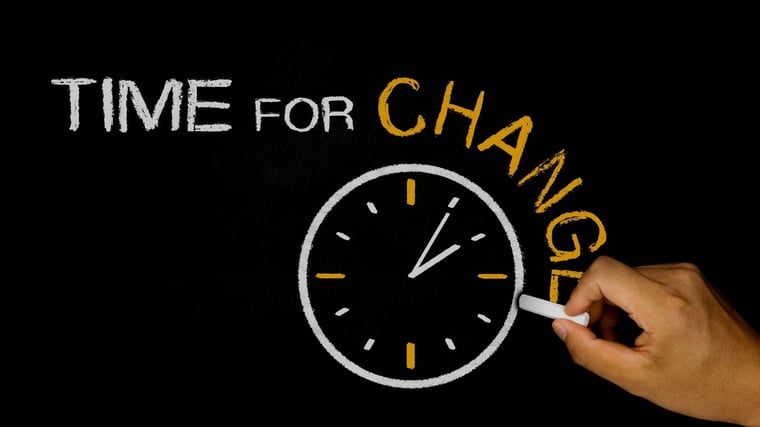
When a new Agile marketing team is first formed, there are many choices members need to make about how they’ll start working together.
Issues come up, stakeholders consult, and team preferences emerge.
These early conversations are a lot like a negotiation. Teams have to consider many group factors, including its assigned projects and the individuals who make up the team.
One of the most significant choices regarding their process a team will make during this period of forming is the one between sprints and flow.
This may seem like a simple either/or decision, but it has a massive impact on a new team’s early experiences with marketing agility.
The choice between sprint and flow becomes crucial to the group’s efficiency, morale, and pace. So, when you’re making this decision, make sure it’s a really informed one.
To help you get informed, this article digs deeper into these two distinct models of value delivery to help your team make this all-important choice.
What are Sprints in an Agile Marketing Process?
First things first, we need to differentiate the sprint and flow ways of working.
If you’ve ever come across Scrum, you’ve probably heard of sprints mentioned outside their typical Olympic context.
In Agile frameworks, a sprint is the name we use to describe a time-boxed iteration of active work for any Agile team. Each iteration (or sprint) represents a short period during which the team executes only on a group of selected projects and their associated tasks.
A sprint may last anywhere from 2 to 4 weeks. During which time no new work is entering the team’s workflow. The entire process and its elements are often visualized in this way:
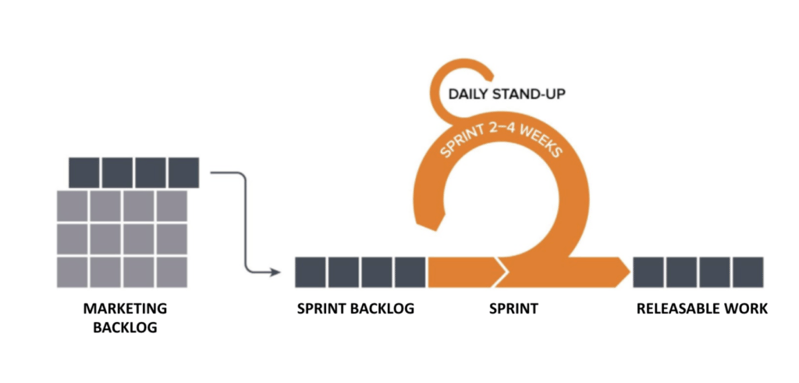
This approach to getting work done is meant to keep the team on track and help them frequently release valuable work.
By preventing them from picking up new work, sprints keep the team from getting distracted from business priorities and encourages them to stay focused.
What is a Flow-based Approach to Agile Marketing?
If the sprint is a short race at full speed, then a flow-based approach to your process can be described as a marathon of bite-sized pieces.
Unlike with sprints, cultivating a process flow is a test of endurance, sustainable pace, and efficiency.
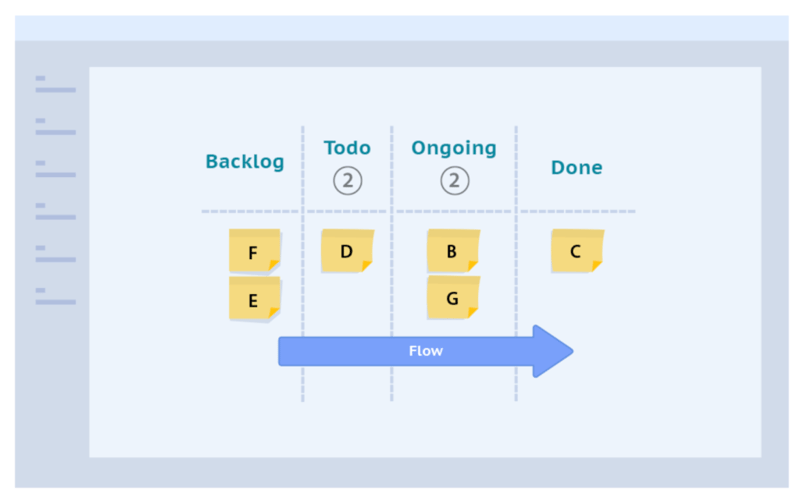
Image from Digité
In process management, cultivating a flow of value within a team means maintaining a continuous delivery of value to your customer at a pace that you can keep up indefinitely.
The concept of “flow” comes from the principles of Lean methodology. In fact, it’s one of the five principles of Lean.
The flow approach suggests that delivering value to your customer as early and as often as possible is the surest way to achieve maximum productivity and flexibility in any given process.
This means that teams aim to create an extremely efficient and dynamic production line, over the course of which no one member is holding onto a batch of work for too long.
The goal of the process is to move forward and build on what you have in very short cycles.
Whether you’re building a campaign or a car, having flow in your process will help you reach completion faster and achieve higher quality at scale.
Comparing Iteration and Flow
The difference between Lean flow and an iterative batching approach (similar to Sprints) is often visualized using the diagrams below.
Imagine a traditional approach to working in a team:
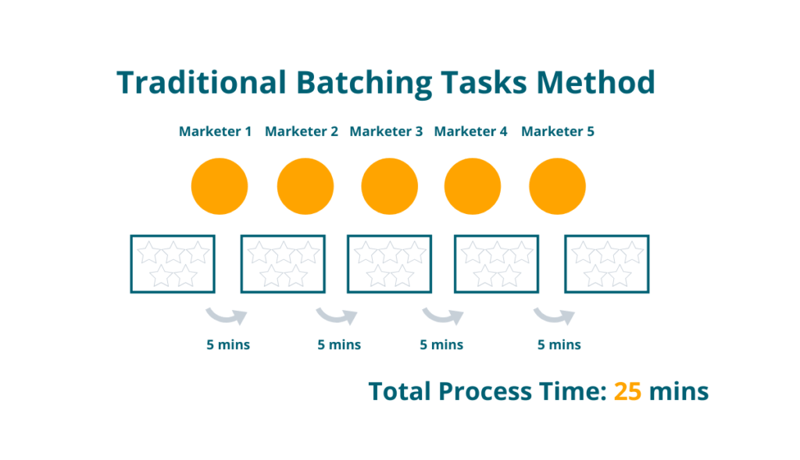
In the example above, markters stay idle, waiting for a batch of five tasks to reach them, so they can contribute to the “project.” The entire system is focused on these five tasks at a given time.
The alternative approach to batching is a faster flow of much smaller batches in a system like the one below.
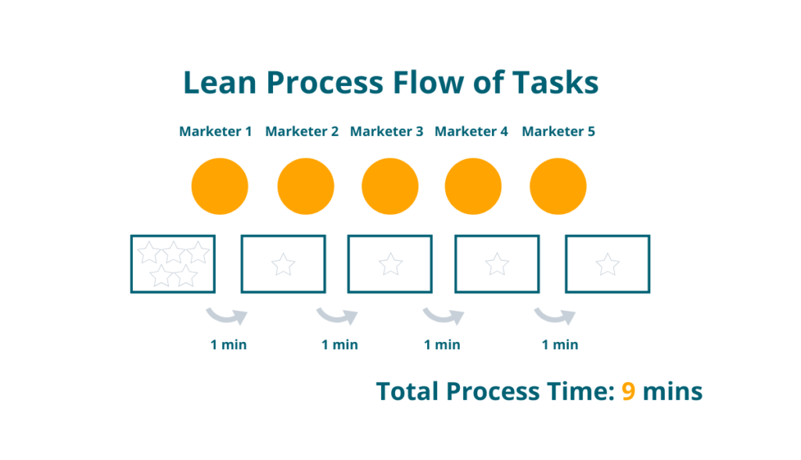
In the example of Lean flow, the team of operators deals with tasks as they come into the system. Every operator contributes to a task, then passes it to the next “station.”
The result?
A much faster total time for process and less waste generated from waiting at various stages.
In Practice: Sprinting Towards Your Sprint Commitments
To start practicing sprints in your teams, you need to be ready to have some honest conversations about how much you can get done in a given timespan. Luckily, there are tried and tested tools to help you figure that out as you continually track how close you are to achieving your sprint goals.
Tools for setting up your sprints right:
- Build a visual workflow to create visibility around process stages.
- Start estimating your work using the Fibonacci Sequence or another sizing format that measures effort required to complete a task. (Ask yourself: How hard is it? rather than How long will it take?)
- Start measuring the team’s velocity to get a sense of how much work you can commit to as a group at the beginning of a Sprint.
- Find a good time for the team to huddle for Scrum’s events, such as Sprint Planning, Sprint Review and Sprint Retrospective. These are mandatory for teams practicing sprints.
- Begin meticulously tracking how your sprints are progressing using a Burndown Chart. This typical metric tracker for Scrum teams helps the execution team as well as their lead. It helps them keep their finger on the pulse of each and every sprint. The burndown helps Scrum teams stay on track as they watch their backlog of committed tasks “burn down” to zero.
In Practice: Cultivating Process Flow & Just-in-time Delivery
To develop your team’s flow, your focus must be on removing any waste in the process and making it more efficient.
Hint! Waste in your process might include any overprocessing of tasks, unnecessary meetings, slow review processes or context-switching between tasks. Check out some common forms of waste here.
Tools to use with your team to cultivate flow :
- Build a visual workflow to map your process carefully and create clarity around active and non-active (ex. When the team is waiting on a review, waiting on design or just blocked and not actively working) stages of your team’s process.
- Identify all of the non-value adding activities you would like to/are able to eliminate in the short-term and long-term.
- Map out a future state in which there is a minimal amount of non-active phases.
- Apply WIP limits to keep work flowing through the system at a fast and steady pace.
- Create simple feedback loops to make sure that you’re increasing quality as well as the speed of the process.
- Enforce “flow time” of zero interruptions when the team can *truly* execute; cluster meetings in the morning or afternoon to carve out “flow time” for the team.
- Continuously revisit the process to eliminate any wasteful stages and make minor or major improvements to how work gets done.
Before proceeding to learn how to mix sprint & flows, why don't you take a second to get our guide on choosing an Agile trailhead?
Mixing Sprints & Flow
As marketers, we have a lot of variety in the type of work we do.
In a given quarter, we’re the team most likely to have the most different types of projects pass through our process.
This variety is both our privilege and our curse.
It requires us to build a process that is broad enough for any type of marketing work to move through efficiently. But, our process should also be specific enough to provide solutions to our team’s process challenges.
That’s why some Agile marketing teams experiment with switching between flows and sprints depending on the project they are working on.
Seeing many examples of this in the past has prompted our team to visualize it as the AgileSherpas Rimarketing Framework:
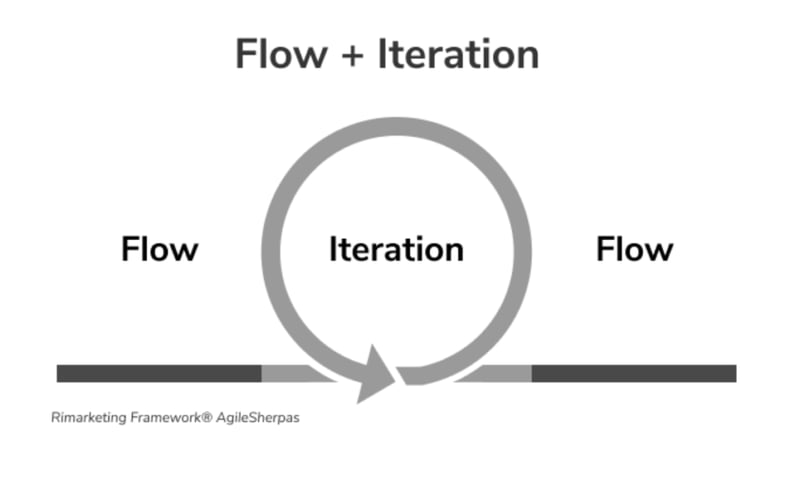
For example, a team may typically practice a framework that leans heavily on cultivating flow in the process, such as Kanban.
This team usually opts to operate using Kanban due to unplanned work they receive from other business units. They also need to be more flexible in making changes and reprioritizing based on these incoming requests.
However, the team sometimes needs to work on a larger initiative (and little else) over the course of a few weeks or months. The deadline of the project is clear, and the dependencies for the team to execute it have been defined.
In periods when the team has few dependencies, a clear deadline, and clear scope, it might operate more like a sprint-based Scrum team.
Sprints are not the usual mode, but they become a more appropriate mode for the type of work the team is doing in that period of time.
Some of the teams we’ve worked with share that switching to stricter time-boxes in these particular cases gets them to their goal faster rather than staying in the “flow” no matter the circumstances.
Once the project is over, they may easily switch back to Kanban using the same workflow visualization.
How to Choose Between Iteration and Flow
During the initial set up of your Agile team, your group will have a chance to discuss whether time-boxing your work or cultivating a continuous flow are more likely to lead to team success in your case.
As you discuss, aim to answer the following questions:
- Does a lot of unplanned work come into the team?
- How does the team prefer to work?
- Do our customers want to receive the value we can deliver?
- What cadence suits the type of work we do?
- What might be the benefits to our team to have a more prescriptive approach vs a faster-paced and adaptive approach?
- When might we use sprints as a technique (if not always)?
- Will running sprints help me work more in sync with external collaborators?
Tackling these questions early will not make your team more familiar with both approaches. It will also make you comfortable to switch between them when you need to.
Whichever approach you choose within your teams, remember to keep your process as customer-centric as possible. At the end of the day, that should always be the most definitive factor you use to make your team decisions.
And of course, nothing is set in stone.
As factors change -- for example, a team member leaving, new members joining, different types of work coming into the team or the team going from co-located to remote -- process rules will also change.
Any marketing teams out there running sprints?
Or are an example of a team that has cultivated a predictable Kanban flow?
Anyone switching back and forth when the occasion calls for it?
Share your journey in the comments below.
Before moving on, don't forget to get your copy of our Choosing an Agile Trailhead Guide.
Topics discussed
Improve your Marketing Ops every week
Subscribe to our blog to get insights sent directly to your inbox.




